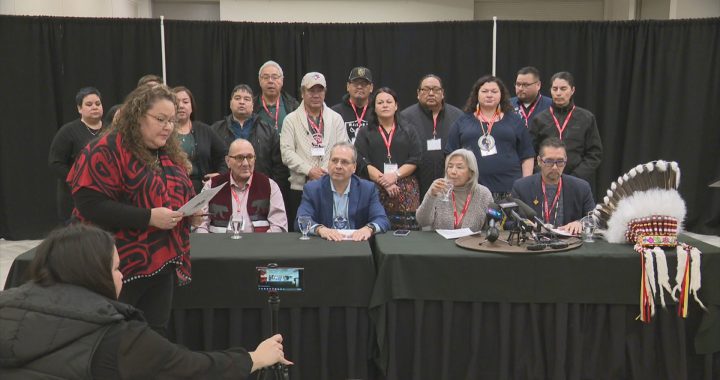The Canadian Press
CALGARY – Clint Big Eagle says the whiff of oil permeated the frigid Saskatchewan air for about a week and a half before he decided to pull over and investigate.
“The kids are all, ‘It’s a terrible, ugly smell. What is that?”’ Big Eagle said in an interview.
That turned out to be a 200,000-litre pool of crude coating a frozen pond, a few hundred metres off the road on Ocean Man First Nation territory.
“That’s an incredible amount of oil not to keep accounted for,” he said.
The pipeline spill, discovered on Jan. 20, is now under investigation by the Saskatchewan government. It said its investigation will try to determine why the pipeline’s leak detection system did not flag the leak.
Tundra Energy Marketing, the operator of the pipeline, did not return messages for comment.
The spill has cast a spotlight on the problems with detecting pipeline leaks, an issue that will become more important with approvals in place to build the Trans Mountain expansion and Line 3 replacement. The two projects would be the first oil export pipelines to start construction in Canada since 2008.
“The current leak detection companies use aren’t particularly effective,” said Carl Weimer, executive director of the Washington-based Pipeline Safety Trust.
In the U.S., where pipeline data is centrally tracked, a study in 2012 for the Pipeline and Hazardous Materials Safety Administration showed the operators’ control rooms detected 17 per cent of oil spills.
In Canada, the National Energy Board only started in 2015 to track in detail how leaks are discovered.
Still, the NEB data is similar to that of the U.S., with control rooms detecting 20 of the 128 leaks of oil, gas and other substances in the past two years.
The Alberta Energy Regulator does not track in its database how leaks are discovered along the pipelines it oversees in the province, though companies are required to submit that information in spill reports. In Saskatchewan, the provincial government asks who submits a spill report but does not require details on how a leak was detected.
The Alberta regulator has looked into leak detection on occasion. Last year, it chastised operators for not maintaining effective programs after finding that improper leak detection was a significant contributing factor in eight of 23 pipeline spills it had investigated since 2013.
“The investigations concluded that company personnel responsible for leak detection were not sufficiently trained or simply failed to recognize that a leak was occurring until several days after the leak had started,” the AER said in a bulletin.
Shortcomings in the control room have been flagged in a number of high-profile spills in the past, including the Husky Energy leak of 225,000 litres last year on the banks of the North Saskatchewan River, where operators waited 10 hours to heed alarm bells and shut off the pipeline.
In 2010, operators at Enbridge took 17 hours to shut down a pipeline after being alerted to a spill. About 3.3 million litres of crude flowed into Michigan’s Kalamazoo River, the largest inland oil spill in U.S. history. Enbridge said it has made significant changes to its spill response since then.
Anthony Swift at the Natural Resource Defense Council of New York said leak detection systems are only able to reliably discover massive spills, but they do little if anything to warn of smaller leaks that can also cause damage.
“It doesn’t take long for a significant leak to become catastrophic for communities and the environment if not detected rapidly,” said Swift.
For its 760,000 barrel-a-day Line 3 replacement, Enbridge estimates its system will be able to detect leaks of a minimum 150,000 litres of oil per hour, or roughly three per cent of pipeline flow.
Kinder Morgan’s Trans Mountain expansion should be able to detect leaks of between two and five per cent of flow, which works out to a minimum of 78,200 litres per hour based on the 590,000 barrel-a-day expansion.
The technology exists to improve those detection rates with a wide variety of sensors running outside the pipelines including vapour-sensing tubes, fibre-optic temperature monitors, hydrocarbon-sensing cables and acoustic systems.
Enbridge, Kinder Morgan and TransCanada have been testing those systems in a joint industry project that started in 2014. But neither company has committed to using the systems on new pipelines.
Instead, they say they will rely largely on a multitude of sensors already needed in pipelines that measure flow rate, pressure, temperature and other indicators, which are plugged into computer models and monitored from the control room to try to detect problems.
The companies say they will supplement those systems by occasionally running sensitive acoustic devices through the pipelines, plus through ground and air surveillance patrols, to help detect smaller leaks. Kinder Morgan has also committed to installing a second software-based modelling system on its line.
In approving Line 3 and the Trans Mountain expansion, the NEB found both they had acceptable leak detection systems and has left it up to their respective companies to decide if they think the more sensitive externally-based sensors are worth the investment.
The two companies said they need more time before deciding if they plan to go ahead with any of the new systems.










